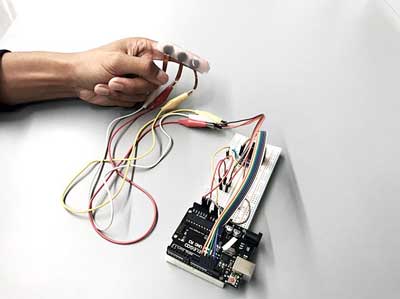| Mar 12, 2019 | |
Movie technology inspires wearable nanogenerator unit that aims to harvest energy(Nanowerk News) A fascination with movie technology that showed robots perform self-repair through a liquid formula inspired a Purdue University professor to make his own discoveries - which are now helping to lead the way for advancements in self-powering devices such as consumer electronics and defense innovations. |
|
| The Purdue team, led by Wenzhuo Wu, the Ravi and Eleanor Talwar Rising Star Assistant Professor of Industrial Engineering, has created wearable technology to convert mechanical energy into electrical energy. | |
| "Our work presents an important step toward the practical realization of self-powered, human-integrated technologies," Wu said. | |
 |
|
| A Purdue University team created wearable technology to convert mechanical energy into electrical energy. (Image: Wenzhuo Wu/Purdue University) | |
| The Purdue team invented a liquid-metal-inclusion based triboelectric nanogenerator, called LMI-TENG. Triboelectric energy harvesting transducers - devices which help conserve mechanical energy and turn it into power - are predicted to be a $480 million market by 2028, according to IDTechEx. | |
| The LMI-TENG can harvest and sense the biomechanical signals from the body and use those to help power and direct technological devices. The LMI-TENG consists of a layer of liquid metal embedded functional silicone sandwiched between two Ecoflex layers. | |
| The Purdue technology is featured in the Journal of Materials Chemistry A ("Wearable high-dielectric-constant polymers with core–shell liquid metal inclusions for biomechanical energy harvesting and a self-powered user interface"), which named it one of 2019's HOT papers. | |
| "We realized that liquid represents the ultimate form of anything that can be deformable and morphing into different shapes," Wu said. "Our technology will enable wearable electronics to take otherwise wasted energy and transform it into energy that can power and control electronic devices and tools used in military defense and consumer applications. Our technology allows the synergistic engineering of TENG components at the material, structural and output levels." | |
| Wu said the Purdue technology has applications for many self-powered innovations for emerging technologies, such as wearable sensors, pervasive computing, advanced health care, human-machine interfaces, robotics, user interfaces, augmented reality, virtual reality, teleoperation and the Internet of Things. |
| Source: Purdue University | |
|
Subscribe to a free copy of one of our daily Nanowerk Newsletter Email Digests with a compilation of all of the day's news. |
